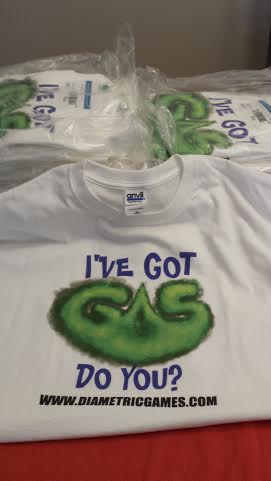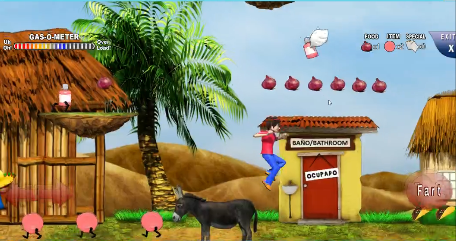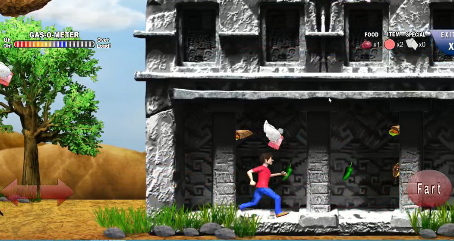Budget Game Promotion at the E3 Conference [CASE STUDY]
As an indie with limited marketing budget, exhibiting at the E3 conference might seem crazy. Space for a booth alone can cost thousands or tens of thousands of dollars. Tack on food, transportation and lodging and you’re looking at a small fortune. But, what if you scratch the booth, get a general admittance ticket and bargain hunt for the rest of your expenses? Then is it possible to successfully market your game at E3 on a budget? Rob Stamper from Diametric Games sure thinks so…because that’s exactly what he did at E3 2014 to promote GAS, a slap-stick, 2D side scroller about making it to a bathroom after eating an exotic meal that isn’t sitting too well.
E3 Conference Case Study:
Diametric Games
Challenge
Diametric games needed to generate awareness for its title, GAS, among potential business partners, fans and press, while staying on a budget.
Solution
Control costs by defining goals and developing a strategy of securing accommodations, needed materials and meetings around those goals far in advance of the event.
Diametric’s E3 Conference Strategy:
-
Define Goals
Before Rob could work on his trade show strategy, he needed to define what he wanted to accomplish. For Rob, E3 was about demoing GAS to as many potential fans as possible, as well as making business contacts. With those goals in place, Rob began to align his strategy. .
.
Avoiding obstacles on the way to the bathroom in GAS. -
Control Costs by Booking Early and Bargain Hunting
Attending any trade show, including the E3 conference, is not cheap. However, one can keep costs way down if he or she is willing to sacrifice convenience for affordability and bargain hunt for everything. For Rob, this included:(1) booking his flight with a discount carrier,
(2) staying at a hotel that offered a shuttle to and from the convention center (to avoid cab fare) and a refrigerator (to store groceries and avoid eating out),
(3) packing lunch every day (to avoid ridiculously priced meals at E3’s cafeteria), and
(4) getting a free E3 2014 ticket by applying as a “member of the interactive entertainment industry.”Between his admittance, travel, lodging and food, Rob spent about $1,800 (a $1,000+ savings from what it could have cost).
-
Secure the Appropriate Materials for the Job
Since Rob would be promoting on foot, he knew he had to find an easy way to demo GAS that did not include lugging his desktop around the show floor, or hassling with his laptop. At the same time, Rob didn’t have $300 to invest in a tablet. However, at the advice of a local electronic store’s staff, he purchased a tablet and took advantage of the 14-day return policy. (Even though the store’s staff suggested this approach, Rob still felt a bit awkward with it). Rob also dropped the game to his smartphone as another option to have on hand.In addition to the actual demo devices, Rob knew he would need some kind of handout to serve as a reminder to fans, and to direct them to learn more. Enter swag. Rob printed business cards, posters and t-shirts as giveaways. And like his ticket, flight, lodging and food, Rob bargain hunted to find a vendor who would print these items at 50 percent off. In total, Rob spent $150 on swag.

GAS t-shirt. -
Set Up Meetings Early
From past experiences, Rob knew securing meetings with potential business partners, press, etc. onsite at E3 2014 would be impossible, so Rob took full advantage of the connect@E3 tool to set up all of his meetings ahead of time. Using this tool, Rob was able to email and call prospective business partners and secure a full schedule of meetings. -
Show the Game to ANYONE
Armed with a tablet and swag, Rob had the right materials in place to effectively demo GAS to anyone. And, that’s exactly what he did. Whether he was walking the show floor, waiting in a line, on a shuttle bus or in a bar, Rob was able to whip out his tablet and show off his game. After he finished each demo, he would direct players to where they could learn more with a business card, poster or t-shirt. -
Take Advantage of Spontaneous Opportunities
While Rob tried his hardest to set up meetings with everyone he wanted to meet with, not everyone could accommodate him. This included Sony. Fortunately, Rob had had casual correspondence with Adam Boyes, VP of Publisher and Developer Relations at PlayStation, over Twitter and happened to recognize his face on the show floor. Rob introduced himself and was able to talk with Adam for about five minutes discussing Canadian beer, GAS and Diametric Games. During that quick five-minute conversation, Adam invited Rob to reach out for help and became a personal and viable contact.
Jumping over a donkey, just one of the many strange obstacles in the game.
Diametric’s Key Take-A-Ways and Lessons Learned:
-
Embrace Failure
Rob’s success at E3 2014 came at the expense of a massive failure last year, where he was met with lots of “no thank yous” and other rejections. However, instead of letting the rejection discourage him, Rob viewed it as a valuable learning experience. He adapted the way he approached E3 2014 from last year’s event and succeeded in his goals. Rob advises all indies to do the same. -
Be Ballsy, but Keep it Real
Potential fans and business contacts are not going to pay attention to wall flowers, so get out there. Send emails, Tweet, introduce yourself and more. The worst anyone can say is “I’m not interested,” but the best has no limits. As you put yourself out there, Rob cautions to be genuine. Pretending to be something that you’re not can come across as phony, whereas authenticity can be quite endearing. -
Don’t Settle for Full Price
If you’re attending a show on a budget, don’t settle for full price on anything. While it may take more time, researching discounts is well worth the effort.
Hastily running through ancient ruins to relieve yourself. -
Secure More Meetings
Once you think you have a full schedule of meetings, try to schedule more. Being in one place with so many potential fans and business contacts is rare–take full advantage of this opportunity. -
Follow-Up
Rob sent personal follow-up notes to every potential fan, business partner and press contact he made (if he got their contact info). In each of these notes, he made sure to comment on something they discussed to make the notes more personal and rememberable.
Result
Diametric Games demoed GAS to over 800 potential fans and made over 200 business contacts, including: Microsoft and Sony. In addition, Diametric secured multiple upcoming reviews on Twitch, as well as other online gaming sources. Overall the studio spent under $2,000 on this effort.
About Diametric Games and GAS
GAS, Diametric Games’ first title, is a fun, funny, and yet very challenging 2D side scroller that presents a new concept to this genre…resource management! Balance your GAS as you pass through the landscape of four different countries (Mexico, Jamaica, India, and Peru) on your way to the bathroom, but be careful! Too much GAS and you explode, but run out and you crap your pants! Great for the serious gamer AND the kid in all of us with easy and hard mode options. GAS is projected to hit Android, Apple, Windows, and possibly Amazon devices around the end of July, with a PC version to follow shortly thereafter. Learn more about GAS.
Diametric Games is an indie studio based out of Ottawa, Canada and founded in early 2012 with the motto “Imagine you could do whatever you want…” DMG is a little out there and having fun, but with a serious dedication to making games at the next level. After all, they’re gamers too! Learn more about DMG.
Follow Diametric Games on twitter @DiametricGames and like the studio on Facebook.
Many thanks to Rob Stamper and the Diametric Games team for allowing me to tell their E3 conference story.

![Budget Game Promotion at the E3 Conference [CASE STUDY]](https://indiegamegirl.com/wp-content/uploads/2014/11/e3-conference-750x400.jpg)

8 Comments
PAUL
about 10 years agoAgain another great blog that shows much wisdom and experience beyoned your ears. You have great insight as well keep up the great work. Try to ease up on blogging and enjoy your engagement a bit. Miss You, Paul and Donna
ReplyNick
about 10 years agoSpending $2k on paid reviews on major app review sites would bring more income, IMHO.
ReplyEmmy
about 10 years agoHi Nick, thanks for the comment. I would advise those considering paid reviews to be very cautious. A paid review, even those where you're just paying for an expedite (i.e., to move your review to the top of a review site's queue), could potentially ruin your credibility. Players and press tend to look down on paid reviews as not trustworthy and can even pass on that mistrust to the developer who purchased them. A better way to spend the money might be on advertising, trade show tix to promote the game, etc.
ReplyDavid H. McGuire
about 10 years agoHi Emmy, I love your blog and I have it set up on my rss feed aggregator. I'm interested to know how one could lose credibility for incentivising a blogger or journalist to review a game. Isn't it the case that the game is either good or bad or in between and the whole experience is for individuals to subjectively determine if it is or isn't. A great game is all relative and it's the bloggers and/or journalists responsibility to just bring awareness to games we are not yet aware of yet. Just my thoughts. David
ReplyEmmy
about 10 years agoHi David, Thank you for your comment and your kind words about my blog. I'm glad you've found it so useful. The potential loss of credibility doesn't necessarily lie with the journalist, but rather the consumer. I agree with you in that whether a review is incentivized or not, it is a journalist's responsibility to write an honest one (and credible journalists do). However, once money enters into the equation, consumers can become skeptical. I.e., "if this review was paid for, does that mean that I can trust it, or would the journalist write a more favorable review because he/she wants to continue receiving funds from developers, etc." And if a consumer becomes skeptical over the integrity of a paid review, they can associate that lack of trust back to the developer, and even warn others, destroying your credibility. This is why I warn developers to be very cautious when considering paid reviews. Hope that helps, Emmy
ReplyGreg Froning
about 10 years agoVery interesting post, blog has some good content. I look forward to reading more content.
ReplyEmmy
about 10 years agoThanks Greg! Glad you liked it...stay tuned.
ReplyLevis
about 9 years agoGood post! Emmy.
Reply